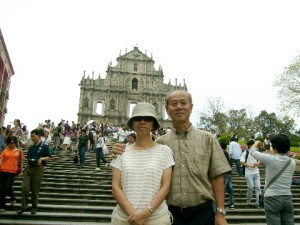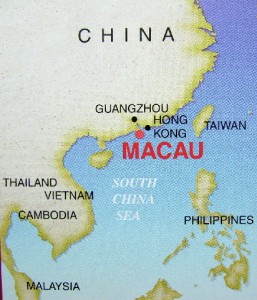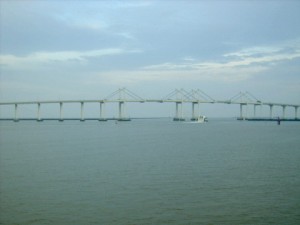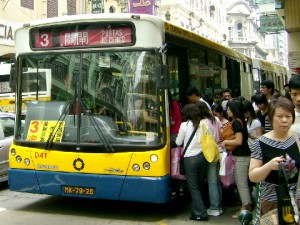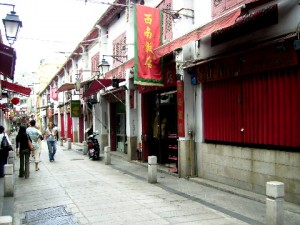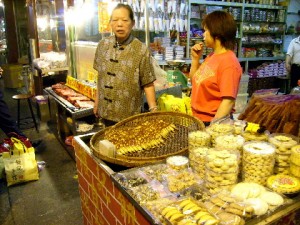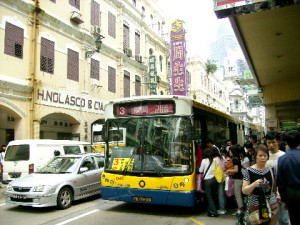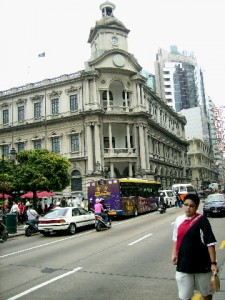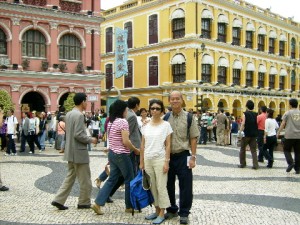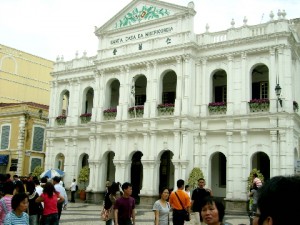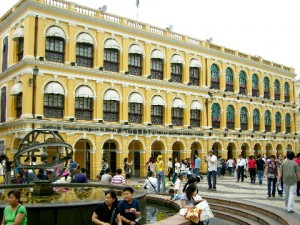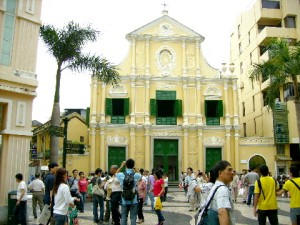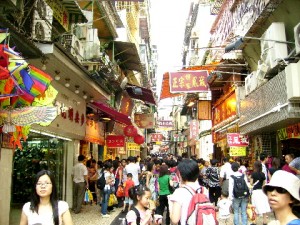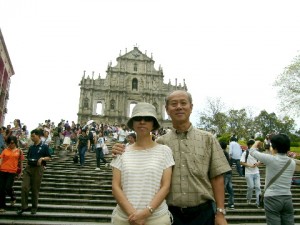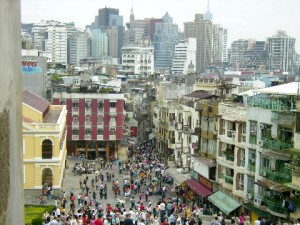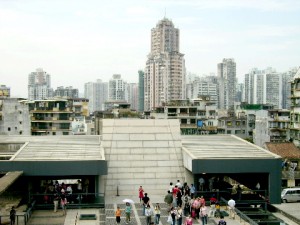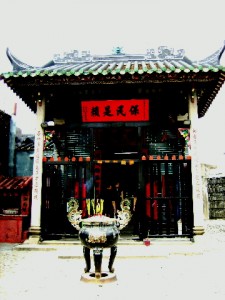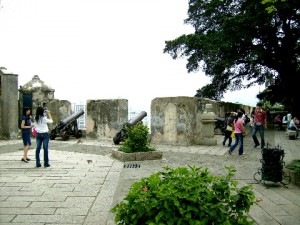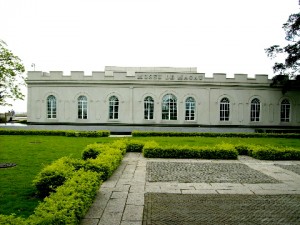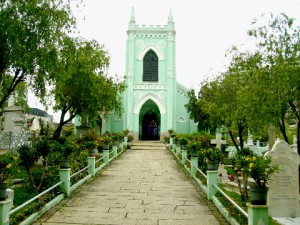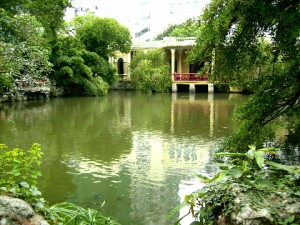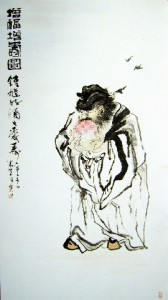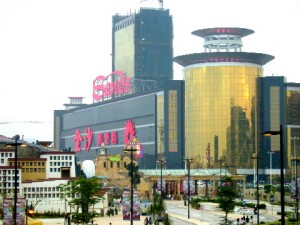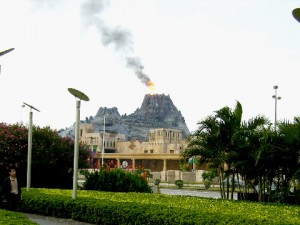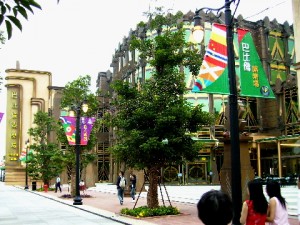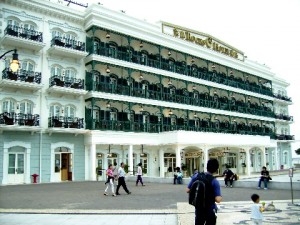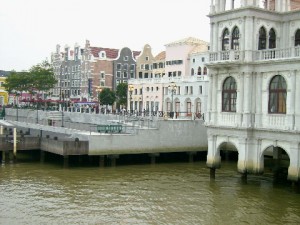Macau Travel
Geography of Macau
Location Macau is in the south-east of China. Located on the west bank of the Pearl River close to its river mouth and 60 km west of Hong Kong, it consists of four parts: a peninsula (Macau), two islands (Taipa, and Coloane) and a reclaimed land (Cotai) which joins the two islands. Taipa island is linked to the peninsula by three long bridges, viz. Friendship Bridge, Macau-Taipa Bridge and Sai Van Bridge.
Population Macau is a tiny territory of 28.2 sq. km. and has a population of about half a million. About 95% of the population is Chinese and the rest Portuguese and other races. Although they belong to different races and practise different religions, traditions and customs, they have co-existed, harmoniously, for many centuries.
Although Chinese and Portuguese are the official languages Cantonese is widely spoken here. English is usually used in trade, tourism and commerce.
Tourism Tourism and gaming industries are the mainstays of its economy. Other industries that contribute, significantly, to its economy are apparels, textiles, electronics, footwear and toys.
Macau is a paradise for night-birds, locals and foreign alike, as it has lots of bars, pubs, karaoke clubs, discos, shops and restaurants as well as casinos that are open all night long.
Transport The common public transport is bus. Scooters are popular vehicles in Macau streets. Trishaws are a common sight in the east of Macau City. They carry tourists for city-sightseeing. There are no trains in Macau.
Most of the names of the roads are in Portuguese and, surprisingly, long. If you do not know Portuguese, it will be difficult for you to pronounce and remember them.
History of Macau
The Arrival of the first European, the Portuguese Before the arrival of the first European, the Portuguese, in the 1550’s, Macau was already a busy Chinese trading port. When the Portuguese came, they established a trading post and later many made it their home.
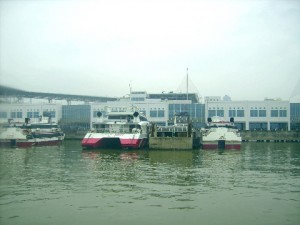
1557 – 1999 Period
In 1557, China allowed Portugal to administer Macau. More than four centuries later, on December 20, 1999, the latter returned the territory to China. Since then Macau has become China’s second Special Administrative Region (SAR) after Hong Kong. It is allowed to enjoy autonomy in all matters except foreign and defence affairs until 2049. On July 16, 2005, ‘The Historic Macau Centre’ was declared as a UNESCO World Heritage Site as it has many architectural legacies, like churches, temples, mansions, fortresses, quaint government buildings and public squares.
Itinerary of Macau Tour
After a three-day tour of Hong Kong my wife and I left Hong Kong for Macau by ferry on 3 May 2007. The ferry ride was rough as the sea was choppy. On arrival at Macau Ferry Terminal, my wife had a slight feeling of nausea. As she could go on we took Bus No. 3 to Macau downtown and checked in at a budget hotel in a street, Rua da Felicidade. Then we left the hotel and began a sightseeing tour of Macau City, immediately.
Below is the itinerary of our memorable Macau tour on 3 May 2007.
1 Macau Roads
2 Senado Square / Holy House of Mercy / Macau Government Tourist Office / St. Dominic’s Church
3 Ruins of St. Paul’s / Crypt and Museum of Sacred Art / Na Tcha Temple
4 Mount Fortress / Macau Sky Tower / Museum of Macau
5 St. Michael’s Chapel / Lou Lim Ieoc Garden / Casinos
6 Macau Fisherman’s Wharf
7 Travel Back to Malaysia
3 May 2007:
Rua da Felicidade (Happiness Road) After checking in at a budget hotel in Rua da Felicidade (Happiness Road), we walked along the road and noticed the old buldings on both sides of the road are small and old. They look like those we saw in Jonker Street in Malacca (Malaysia). Incidentally, Malacca was once a Portuguese territory too. A few of these buildings have become budget hotels for backpackers and restaurants.
Cookie Shop In the same street, there are many shops making and
selling Chinese pastries or cookies, such as almond cakes, egg rolls and cashew-nut cookies as well as red, sweet BBQ thin slices of meat. These cookies shops can also be found in other streets in the Macau Downtown. When we stopped at a shop, a lady-owner generously gave us some small pieces of cookies to try. After tasting a few, we found that we liked the almond cookies the most. They melted slowly in our mouths and the small pieces of almond nuts in them were fresh and crunchy. So my wife bought several boxes of them as presents for our relatives and friends back home in Malaysia.
Avenida Almeida Ribeiro Later, we were in the busiest street in
the city, Avenida Almeida Ribeiro. It is like Orchard Road in Singapore or Nathan Road in Hong Kong. It is difficult to walk on the crowded five-foot ways in the street without being knocked or knocking on somebody, accidentally. On one occasion, I accidentally knocked a man and apologized to him. But he just walked on. I guess it is a common incident in any crowded place and everybody tolerates it.
This street is a tourists’ shopping paradise. Shops sell all kinds of goods like electrical and electronic items, mobile phones,
jewellery, curios, apparels, antiques, traditional Chinese foodstuffs, herbs and medicine, fast food, local and exotic cuisine, watches and Chinese cookies.
Along this road, besides tall, modern buildings, some large quaint ones of fine architectural designs can be seen. A few fine examples are the one that houses the General Post Office, another a bank, China Construction Bank, and another also a bank, Banco Nasional Ultramarino.
Senado Square (Largo do Senado) Near the General Post Office is Macau’s most famous public square known as Senado Square. It is one of the eight squares in Macau. The rest are Barra, Lilau, St. Augustine, Cathedral, St. Dominic, Company of Jesuits and Camoes. Senado Square is surrounded by pastel-coloured neo-classical buildings, creating a Mediterranean ambience. Holy House of Mercy,
the Macau Government Tourist Office and St. Dominic’s Church are some of the quaint buildings located there. The Square has been used for public events and celebrations for centuries. Lots of tourists and locals alike like to visit this beautiful place.
Holy House of Mercy (Santa Casa da Misericordia) This neo-classical style building was founded by the first Bishop of Macau in 1569. It was an institution for western-style medical clinic and other social structures. It is the only white building at Senado Square.
A Museum The House of Mercy houses a museum that was opened in 2001. Its exhibits feature the history of the House itself as well as Macau. They include paintings, manuscripts, a bronze
bell, ivory statues, religious artefacts and Chinese, Japanese and European porcelain pieces.
The Macau Government Tourist Office Opposite Holy House of Mercy is a three-storey yellow building which houses the Macau Government Tourist Office. Free consumer brochures, maps, guidebooks and shopping guidebooks are available here. These are also available at the Ferry Terminal, Airport Arrival Hall, Guia Lighthouse and other places. They provide useful information for tourists like us.
St. Dominic’s Church (Igreja de S. Domingos) Next to the Macau Government Tourist Office is a well-known church, St. Dominic’s Church. This church was built by three Spanish Domincan priests from Mexico in 1587. Its stone facade is yellowish and has white stucco and green-shutted windows.
Inside the church is an altar that has a white statue of Virgin Mary and Child and a painting of Jesus Christ. Some carved ivory and wood saints can be seen inside too.
The Church’s Past History In the past, St. Dominic’s Church had a few violent and dramatic incidents. In 1644, a military Portuguese officer who was a traitor was murdered at the altar during Mass. Then in 1707, the local soldiers tried to enforce an excommunication order on the Dominican friars for supporting the Pope against the Macau’s bishop in the Rites Controversy. But the latter locked themselves in the church for three days, throwing stones at the soldiers. In 1834, when the monastic orders were crushed, the Macau government used the church as a barrack, stable and public works office for a time.
First Portuguese Newspaper It was in this church that the first Portuguese newspaper, A Abelha da China (The China Bee), in the east was printed on 12 September 1822.
There is a museum from the 1st. to 3rd. floor in the church, exhibiting paintings, sculptures and liturgical objects that depict the rich history of the Roman Catholic Church in Asia. It is opened to public since 1997.
Opposite St. Dominic’s Church is a quaint, yellow four-storey building. Its architectural design is similar to the one that houses the Macau Government Tourist Office. It is now a popular place for food lovers who have a choice to savour Chinese cuisine at Chua Lam Gourmet Kitchen or western fast-food at Mcdonalds.
Ruins of St. Paul’s (Ruinas de S. Paulo)
While we were walking on a narrow road, Rua de S. Paulo, from Senado Square to the Ruins of St. Paul’s, we were amazed to see the road crowded with tourists: some going up to the Ruins of St. Paul’s, some coming down to the Senado Square and others stopping by to shop. When we reached the Ruins of Paul’s, we were awestruck to see it still standing majestically on a high ground. This stone facade is all that is left after a church, the Church of Mater Dei (Mother of God), was burnt down in 1835.
The Jesuits The church was built by the Jesuits (members of the Society of Jesus) in 1602-1640. The monumental ruins is now Macau’s icon.
If one stands in front of the magnificent facade and looks closely, one will see carvings and small figures on it. It has statues of Virgin Mary and saints, symbols of the Garden of Eden and the Crucifixion, angels and the devil, a Chinese dragon and a Japanese chrysanthemum, a Portuguese ship and pious warnings in Chinese.
We went behind the facade, climbed up a steel staircase, stood on a high platform, looked through one of the windows in the facade and were captivated by a panoramic view of the Macau Historic Centre below.
The Crypt and Museum of Sacred Art Located behind the
facade is the Crypt where the remains of the martyrs of Japan and Vietnam in urns are displayed. Adjacent to it is a museum, Museum of Sacred Art, where one can see exhibits of paintings, sculptures and liturgical objects of the churches and monasteries of Macau from the 16th. to the 19th. century. These exhibits are testimony to the rich historical past of the active Christian missions in Macau and the Far East.
Na Tcha Temple (Templo de Na Tcha) When we came out of the Ruins of St. Paul’s, we were surprised to see a small Chinese
traditional temple, Na Tcha Temple, on the right-hand side of the Ruins. It was built for a child deity in 1888 by the Chinese who prayed to him for help to contain the plague then. I saw some devotees praying inside. They could be asking the deity for happiness, peace, harmony, prosperity, good health or help to solve their personal problems.
Mount Fortress / Monte Fort (Fortaleza do Monte) We left the Ruins of St. Paul’s and walked up a few fights of steps to a fort, Mount Fortress, nearby. It is a large fortress on the highest hill in the Macau city. It was built
in a trapezoid shape in 1617-1626 and was armed with large cannons pointing in all directions to protect the city in the olden days. Some cannons made in 1860 can be seen on top of the fort and are now a tourist attraction.
A Panoramic View of the Macau City From the top of the fort we had a spectacular panoramic view of the Macau city. We saw many city landmarks such as the Sky Tower in the distance, hospital, high-rise commercial, residential and historical buildings, and churches. Tall buildings are built in the city as land is scarce there.
Macau Sky Tower This tower looks like the one I saw in Auckland in New Zealand in 2003. Its height of about 338 metres is 10 metres shorter than the Auckland Sky Tower. The tower is used for telecommunication and broadcasting and is opened to public since December 19, 2001. It is a popular tourist attraction as it has an observation deck with panoramic views, restaurants, theatres, shopping malls and the skywalk. The skywalk is not for the faint-hearted as the walk is round the outer rim of the tower, 233 metres above the ground. For the thrill-seekers, they can jump off the rim while they are being tethered with a long elastic rope. This is like a
bungee jump. If you have watched an episode in a reality show ‘The Amazing Race: All Stars‘, this tower was used as a roadblock requiring the competitors to do the bungee jump.
Museum of Macau Mount Fortress has a museum known as Museum of Macau. It has three floors of exhibits. The exhibits on the first floor show the historical past of Macau. On the second floor are exhibits that feature different aspects of popular art and traditions of Macau and the third floor shows the modern Macau city.
Chapel of St. Michael After visiting Mount Fortress and Museum of Macau, we walked to Lou Lim Ieoc Garden. On the way, we came across a small green chapel with white stucco and stained glass windows built in a Catholic cemetery. It is known as Chapel of St. Michael and was built in 1875.
Lou Lim Ieoc Garden When we entered Lou Lim Ieoc Garden, we thought it was a beautiful Chinese garden. It is built in the classic Suzhou style with a landscape of flowers, bamboos, rocks, a lake teemed with fish and tortoises and tall plants. It is shady and a
pleasant place to relax and enjoy its charm and beauty. Besides, it has a pavilion, moon gates, a colourful Chinese mural on a wall, an old Chinese house and another new but bigger one, creating an atmosphere of an imperial Chinese garden. Undoubtedly, many local senior citizens like to spend their time there making it as their retreat. When we were in the garden, we saw many of them doing light exercises, playing Chinese chess, catching up on each other’s news and relaxing.
When we entered the new building we were lucky to see an exhibition of Chinese paintings of and calligraphy of a local artist, Gao Lijie (Gao Yin). His 46 exhibits feature animals, human portraits, flowers and landscapes. It was quite an impressive exhibition.
Sands Casino Later, we left Lou Lim Ieoc Garden and took a taxi to Sands Casino. Sands is one of the 28 casinos in Macau. The others are Lisboa, Mandarin Oriental, Fortuna, Galaxy, Rio, President, Babylon, StarWorld, Marina, Grand Waldo, Emperor Palace and Golden Dragon to name a few. Among all the Macau casinos, Sands is the largest so far. It has four floors of many kinds of gambling, like slot
machines, roulettes, dice and card games. A new Macau casino will be ready in August 2007. It is located on a reclaimed land known as Cotai Strip between Taipa Island and Coloane Island. The new casino, The Venetian, will be the largest in Asia and the second in the world.
A Crowded Casino Before entering Sands Casino, we were thoroughly checked for weapons by its security guards. We were not allowed to bring in bottled drinks as they feared that they might be inflammable liquids. When we were inside Sands Casino we were
amazed to see lots of people gambling on all the flours. I noticed most of the gamblers were from Mainland China and Hong Kong. After spending a short time at the casino watching some of them gamble, we headed for a large theme park, Macau Fisherman’s Wharf, which is on the waterfront nearby.
Macau Fisherman’s Wharf At this theme park, there is a 40-metre high man-made black volcano. It belches out smoke and fire with a loud explosion, frequently. It is in an area where there is fun and excitement for children at ‘Vulcania’, ‘Aladdin’s Fort’ and ‘The Underground Amusement Center’.
An International Atmosphere The theme park is unique as it
has many kinds of buildings of different architectural styles, creating an international atmosphere. Each building is given a name of a well-known place where it has the same type of buildings or a famous building that looks similar, like Roman Amphitheatre, Rome, Palace, Italian Riveria, Trinidah, Havana, Amsterdam, Mississippi, New Orleans, Tang Dynasty and Potala Palace. These buildings house restaurants serving local and exotic cuisines, shops selling goods ranging from souvenirs to jewellery, bars, cafes and many more.
At this park, gamblers can try their luck at a large beautiful casino, Babylon, or Flamingo Slot Club which has 285 slot machines. Visitors can stay at a Victorian-style hotel, Rocks Hotel. They may visit a bank which is adjacent to the casino. Since the park has so many facilities, it can be a township itself.
As the park covers a large area (111,500 sq. m.), visitors can hop on to small tour-buses for a free ride.
After visiting a few interesting places in Macau in one day, we went back to our budget hotel.
4 May 2007 Travel Back To Malaysia
On the following morning of 4 May 2007, we left our hotel in the Macau downtown and travelled to Macau Airport. Before entering the immigration checkpoint, we had to leave our drinking bottles behind as they exceeded 100 ml. (Most international airports in the world are now disallowing passengers to carry more than 100 ml. of liquid, gel or cream in a container for security reasons.)
Later, we boarded an Air Asia plane and flew back to our country, Malaysia, bringing along with us fond and memorable memories of the Macau tour as well as the Hong Kong tour. The smooth flight took 3 hrs. and 40 mins.
That’s all about my Macau travel. I hope the information is useful to you.
Written by Choo Chaw, Kl;uang, Johor, Malaysia
Hong Kong Travel / Home / Shenzhen, Hezhou, Quilin, Zhaoqing Travel

